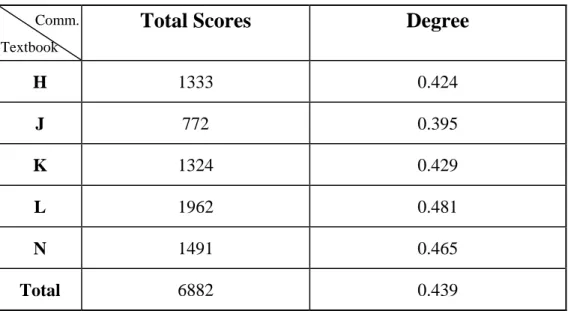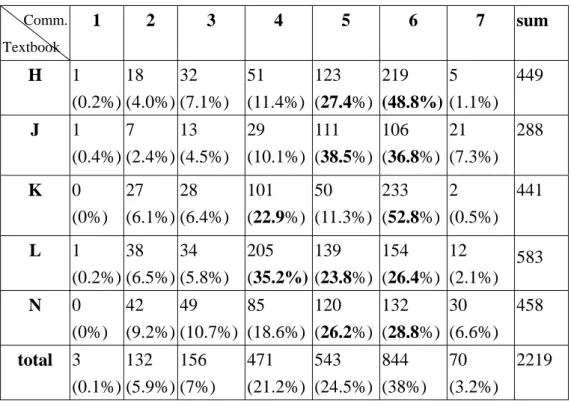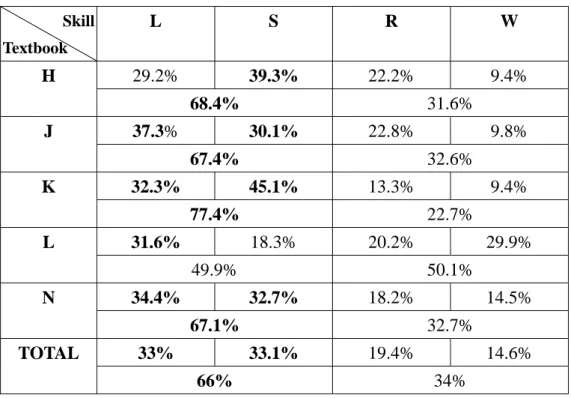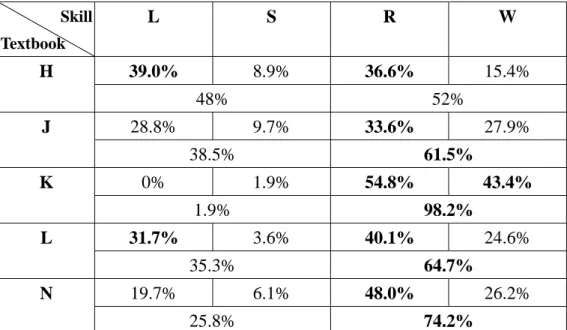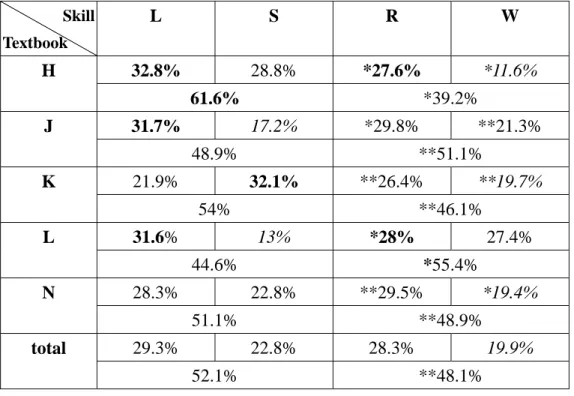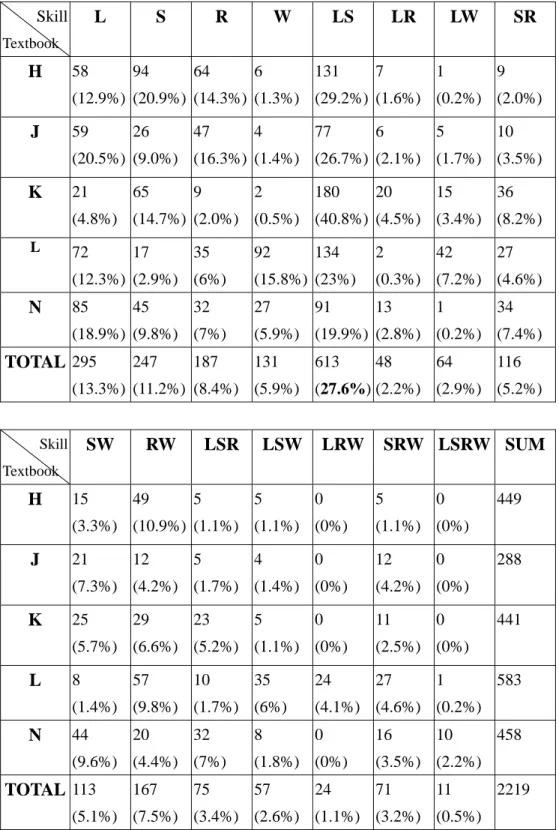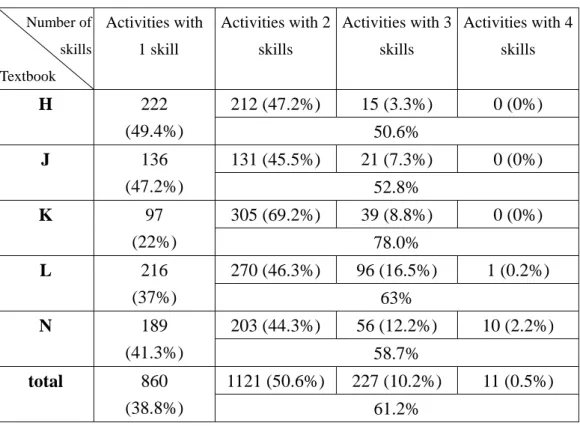Chapter 5 Discussion
The quantitative data of the language learning activities in the five sets of textbooks were presented in the previous chapter. Chapter 4 has provided a general picture of the results of classifying language learning activities in the five textbook series according to communicativeness and the focus of four language skills. The results showed that though in the same version of textbooks, activity designing, in terms of the communicativeness and the focus of four skills, varied in different volumes. Below is a close examination of the results in detail which helps get insights into the activity designing in five textbook series by different writers. Several issues are noteworthy.
5.1 Communicativeness of Activities
5.1.1 Scoring
As have been mentioned in Chapter 3, the communicativeness degree can be calculated as follows:
The degree of communicativeness=
The communicativeness scores / ( 7 x the total number of activities) The communicativeness scores =
7 x Category1 + 6 x Category 2 + 5 x Category 3 + 4 x Category 4 + 3 x Category 5 + 2 x Category 6 + 1 x Category 7
Table 5-1 shows the scores and degrees of communicativeness of the five
textbook series.
Table 5-1 Scores and Degrees for Communicativeness in Activities of Five Textbook Series
Comm.
Textbook
Total Scores Degree
H 1333 0.424
J 772 0.395
K 1324 0.429
L 1962 0.481
N 1491 0.465
Total 6882 0.439
Note: Comm.=communicativeness
The data clearly shows us that the communicativeness degree of five
textbook series is not high. The highest communicativeness degree falls on
Textbook L, which indicates that the activities in Textbook L are the most
communicative of all the five textbook series. In the market of junior high
school English textbooks, Textbook L the only foreign publisher with
accumulated ripe experience in compiling professional language materials,
produces more authentic, more original, and more communicative English
materials than Taiwan local writers. Table 5-1 shows that Textbook J gets the
lowest communicativeness degree and next to it is Textbook H. This indirectly
reveals that activities in these two sets of textbooks are less communicative as
compared with other three textbook series. It is worth mentioning that the two
publishers stopping re-producing the tentative textbook series as the formal
version in 2004 are exactly Textbooks J and H. Tentative versions are
designed only for the first year of Nine-year Integrated Curriculum in Taiwan,
and formal versions are designed for following years. Textbooks J and H continue the competition with other English textbook publishers in the market of formal versions in the following years, but their formal versions are totally new series; while the formal versions of Textbooks K, L and N are revised and improved from their tentative versions depending on teachers’ suggestions and comments after the practical adoption in real teaching.
5.1.2 The predominance of less communicative activities
To examine the communicativeness in the five textbook series more thoroughly, the results of assessing language learning activities based on Dubin and Olshtain’s communicativeness scale are summarized in table 5-2.
Table 5-2 Communicativeness of Activities in Five Textbook Series
Comm.
Textbook
1 2 3 4 5 6 7 sum
H 1 (0.2%)
18 (4.0%)
32 (7.1%)
51 (11.4%)
123 (27.4%)
219 (48.8%)
5 (1.1%)
449
J 1 (0.4%)
7 (2.4%)
13 (4.5%)
29 (10.1%)
111 (38.5%)
106 (36.8%)
21 (7.3%)
288
K 0 (0%)
27 (6.1%)
28 (6.4%)
101 (22.9%)
50 (11.3%)
233 (52.8%)
2 (0.5%)
441
L 1 (0.2%)
38 (6.5%)
34 (5.8%)
205 (35.2%)
139 (23.8%)
154 (26.4%)
12 (2.1%)
583 N 0
(0%) 42 (9.2%)
49 (10.7%)
85 (18.6%)
120 (26.2%)
132 (28.8%)
30 (6.6%)
458
total 3 (0.1%)
132 (5.9%)
156 (7%)
471 (21.2%)
543 (24.5%)
844 (38%)
70 (3.2%)
2219
Textbook J which also demonstrates the lowest communicativeness degrees
as shown in Table 5-1 possesses the smallest number of language learning
activities, and Textbook L which also demonstrates the highest
communicativeness degrees has designed the largest number of language learning activities. J has far less language learning activities than the other four textbook series, and this might indirectly lead to the incompleteness of communicative activities. According to Dubin and Olshtain, activities are better arranged from less communicative to more communicative. Subtracting the basic and necessary activities in English textbooks, there are only a small number of activities left in Textbook J. The rest few activities would be hard to develop to very communicative ones. On the contrary, Textbook L has far more activities than the other four series, and the great number of activities leave more room for the communicative potential in Textbook L.
Apart from the very different total number of activities, we see the prominence of Categories 4, 5 and 6 in all the five textbook series; whereas Category 1 and Category 7, in sharp contrast, are absolutely “the minority.”
In fact, the total number in Category 1, that is the most communicative activities in Dubin and Olshtain’s communicativeness scale, is only 3 in a total of 2219 activities in all the five textbook series. In addition, according to Johnson (1982) and Richards & Rogers (1986), the activities in Dubin and Olshtain’s categories 1 to 4 can be regarded as communicative activities. That is, 22.7% of the activities in Textbook H, 17.4% in Textbook J, 35.4% in Textbook K, 47.7% in Textbook L, and 38.5% in Textbook N are communicative activities. In sum, less than half of all the language learning activities in five textbook series, 34.2%, are classified as communicative activities.
Of all the five sets of textbooks, Textbook L includes the greatest number
of communicative activities, 47.7%; however, it’s less than half. Textbook J and
H which show the lowest communicativeness degrees undoubtedly contain
much less communicative activities than the others. Following the world’s trend of English teaching, Curriculum Guidelines in Taiwan explicitly announce the importance of communicativeness in local English teaching. Publishers in keen competition among the open textbook market should not neglect this statement, and textbook and activity designing are advised to follow this principle.
Surprisingly, all the five sets of textbooks contain large number of less communicative activities.
Dubin and Olshtain state that the scale provides material designers with a mechanism in a syllabus for the selection of language learning activities. A progression of activities can be arranged in such a way to enable learners to move from less to more communicative tasks. Though English becomes a required subject in elementary school these years, English at present is still a foreign language in the local setting. According to the Curriculum Guidelines promulgated by the MOE, the elementary school students in Taiwan have only one to two periods of English class, 40 minutes for each period, in one week.
English learning of junior high school students in Taiwan is therefore regarded as belonging to the initial stage, which principally is concerned with less communicative tasks. According to Dubin and Olshtain, activities are better arranged from less communicative to more communicative. This can explain why the five sets of English textbooks all contain more less-communicative activities than more-communicative ones.
In addition, some peripheral findings were gained when comparisons were
made among the five sets of textbooks. As we compared the proportions of
individual categories in the five sets of textbooks, a noticeable difference is
found, namely, the distribution of 7 categories in the five textbook series are
similar to each other. Activities in all the five textbook series mainly fall into Categories 6, 5, and 4, and only few into Category 1. A closer look of the comparisons then reveals some interesting facts. First, of all the five sets of textbooks, when comparing the number of activities in Category 4, we found Textbook L has the largest number of activities. This contributes to the preceding place in communicativeness among all the five sets of English textbooks. On the other hand, with regard to Category 6, Textbooks K and H have much more language learning activities than the other sets of textbooks. It is a striking fact that more than half of the activities in Textbooks K belong to Category 6. If the activities of Category 6 in Textbook K and H are examined, it was found that every lesson in Textbook K has the activities “tongue twister”
and “chant (song)”. So do Textbook H which includes a “tongue twister (song)”
and two “listen and read out” every lesson. “Listen and read out” is an activity for students to get familiar with the important sentences in that lesson. Since the focuses of these activities are all on form, without attention to the meanings, these activities are classified into Category 6, and this boosts the number of activities in Category 6 in Textbooks K and H. Songs and chants are highly recommended in English textbooks in the Indication of Four Skills by MOE for the purpose of developing speaking ability in elementary school stage.
However, in junior high school stage, singing songs and chants are not included in the Indication of Speaking Ability.
Moreover, as mentioned in the previous section, Textbook J gets the lowest
communicativeness degree. Table 5-2 demonstrates that of all the sets of
textbooks, it is also Textbook J that Category 1 to 4 accounts for the smallest
proportion, 17.4%; however, in the less communicative categories, Category 5,
6, and 7, Textbook J gets the largest proportion, 82.6%. Another set of English textbook, Textbook H, gets low communicativeness degree also because the large proportion, 77.3%, in Category 5, Category 6 and Category 7.
Although Textbooks H and J have more less communicative activities than the other three textbook series, they both possess one very communicative activity of Category 1, of which the number in all the 2219 activities of the five textbooks is only 3, one is in L, and the rest two are in Book One of Textbooks H and J. Both of the Category-1 activities are optional. According to the note beside the activities in Textbook J and the suggestion in Textbook H’s teacher’s manual, teachers can skip these activities depending on students’ English proficiency. The Category-1 activities in Textbooks H and J are similar to each other. They are both guessing games which require fluent English answers to the questions asked by other students. Through simple negotiations (asking and answering), students can guess who the “ghost” is. Nevertheless, Textbooks H and J do not design Category-1 activities in the following volumes.
It’s natural and logic that the publishers just transform the tentative version
into the formal version, with a certain degree of revision, if the formal proves to
be successful. However, publishers as Textbooks H and J seem to notice the
forementioned drawback. They both gave up the tentative series and compiled a
brand new series for the following year, 2003. In the third year of Nine-year
Integrated Curriculum, 2004, Textbook J even re-produced another totally new
textbook series and stopped the previous two series in 2002 and 2003. Though
Textbook H did not design another totally new textbook like they did in 2003,
they did some corrections and improvements on the formal versions produced in
2003. In order to examine if there’s any improvement in activity designing of
Textbooks H and J, Table 5-3 are presented with an analysis of the communicativeness of activities in the latest Textbooks H and J of 2004.
Because they were the latest versions during this study, only the first two volumes published could be analyzed.
Table 5-3 Communicativeness of Activities in New Textbooks H and J (2004)
Comm.
Textbook
1 2 3 4 5 6 7 total degree
H
0 (0%)0 (0%)
3 (2.7 %)
28 (**25%)
27 (24.1 %)
54 (48.2 %)
0 (0%)
112 0.403
J
0 (0%)0 (0%)
9 (*7.8%)
22 (*19%)
40 (34.5%)
32 (27.6%)
13 (*11.2%)
116 *0.406
Note: *increase **increase more than 10%
First, we found the manifest increase in the number of activities in the latest version of Textbook J. Besides, the proportions of communicative activities increase in both the latest version of Textbooks J and H. The proportion for activities of Category 4 in H increases greatly from 11.24% in tentative series (see Table 5-2) to 25% in the latest version. Textbook J’s improvement in communicative activity designing is even greater with the proportion of communicative activities in Category 3 from 4.5% (see Table 5-2) to 7.8%, Category 4 from 10.1% (see Table 5-2) to 19% and that of the less communicative activities in Category 5 decreases from 36.8% (see Table 5-2) to 27.6%. The latest version of Textbook J (2004) also gets higher communicativeness degrees than the version of 2002. However, the improvement in the latest version of Textbooks H and J is not evident enough.
The proportions they have in communicative activities are still lag behind the
tentative versions of Textbooks K, N, and L, and so do their communicativeness
degrees.
5.1.3 Reflections on the use of Dubin and Olshtain’s communicativeness scale
According to Ddubin and Olshtain’s communicativeness scale, Category 7
“new information is received” represents the least communicative activity, and Category 6 “no information is proceed; focus is on form” is more communicative. However, if we examine the two categories with examples, some contradiction could be identified. Take the following activities from Textbook L for example.
A Category-7 activity form Starter Unit in L Book 4
Welcome to Brown Junior High’s School Festival!
Date Saturday, October 18th Time 9:00 a.m.~ 4:00 p.m.
--- Morning
9:00 Visit Classrooms
10:00 Video of our School’s History 12:00 Lunch
Afternoon
1:30 Basketball Game 3:00 Song Festival
In addition to the main text which already includes a reading passage,
almost every unit in Books 3 and 4 of Textbook L also has another reading
activity in the last section “Keep writing.” These activities are designed to
develop writing skills. Students are asked to read the short example first, and
after the reading they have to write their own. This kind of activity corresponds
to Category 7 in Dubin and Olshtain’s communicativeness, exposure only, without any physical response.
A Category-6 activity form Unit 3 in L Book 1
According to Dubin and Olshatain, a Category-6 activity may include reading aloud with attention to pronunciation, that is, with a focus on form.
Listen-and-say activity is a typical Category-6 activity.
However, if we compare these two activities above, we may find that the Category-6 activity is not more communicative than the Category-7 activity as Dubin and Olshtain has stated. Although the Category-7 activity does not need any verbal or physical reactions and the Category-6 activity requires students to utter out the sounds, the Category-7 activity is more meaningful than the Category-6 one. Students have to understand the meaning of the reading characterized as Category-7, while they only have to do mechanical operations in the Category-6 activity. The Category-7 activity is more challenging for students than the Category-6 one.
Besides, according to Johnson (1982) as well as Richards & Rogers (1986), activities of Categories 1 to 4 in Dubin and Olshtain’s communicativeness scale can be regarded as communicative activities. But Category 1 “new information is negotiated”; Category 2 “new information is expressed”; as well as Category
Listen and say Consonant sounds:
〔m〕 map 〔n〕nap ………
gum run ………
3 “new information is used or applied” all need students to express their own ideas. These activities focus on the content students express. They are more learner-centered or content-based. On the contrary, Category 4 “new information is transferred”; Category 5 “new information is received, but there’s no verbal reaction”; Category 6 “no information is proceed, focus is on form”;
as well as Category 7 “new information is received, exposure only” are more teacher-centered or language-based.. Teachers have to offer some information for students to copy, to do some response, or even to do nothing. As illustrated in the above classification, the dividing line between Category 4 and Category 5 is not as evident as that between Category 3 and Category 4. The activities in five textbook series mainly fall in Categories 4 to 6, with high percentage of 87%. If only Categories 1 to 3 are communicative activities, only 13% of all the activities are communicative activities.
5.2 The Focus of Skill in Activity Designing
5.2.1 Listening and speaking over reading and writing
Mastery of all English skills is perceived as crucial for learning English.
Listening, speaking, reading, and writing are all necessary tools for learners if
they are to emerge successfully in English. For this sake, a balance of
appropriate listening, speaking, reading, and writing skills in the teaching of
junior high school stage are suggested in Curriculum Guidelines in Taiwan. In
view of this, the inspection and comparison of the percentages of four language
skills in textbooks are needed. The percentages of four language skills in
activities included in the five textbook series are shown in Table5-4 below.
Table 5-4 Focus of Skills in Activities in Five Textbook Series
Skill Textbook
L S R W
29.2% 39.3% 22.2% 9.4%
H
68.4% 31.6%
37.3% 30.1% 22.8% 9.8%
J
67.4% 32.6%
32.3% 45.1% 13.3% 9.4%
K
77.4% 22.7%
31.6% 18.3% 20.2% 29.9%
L
49.9% 50.1%
34.4% 32.7% 18.2% 14.5%
N
67.1% 32.7%
33% 33.1% 19.4% 14.6%
TOTAL
66% 34%
Comparing and analyzing the percentages of four language skills in the language learning activities, we find the obvious imbalance of listening, speaking, reading, and writing in the textbooks. In general, activities involving listening and speaking in the five sets get higher percentages than those involving reading and writing. Listening and speaking together get 68.4%, 67.4%, 77.4%, 49.9%, and 67.1% respectively in Textbooks H, J, K, L and N.
Four sets of the textbooks do not achieve a balance among the four language
skills. It implies that the Textbooks H, J, K, and N do not conform closely to the
goals specified in the Curriculum Guidelines. Listening and speaking both play
a pivotal role in Textbooks H, J, K, and N. In contrast, writing skill is weak
especially in Textbooks H, J, and K. The imbalance of four language skills is the
most serious in Textbook K of all the five. The finding above brings up some
directions for further discussions.
The dominance of listening and speaking activities over reading and writing activities suggests the limitations faced by the textbook writers in Taiwan. First of all, it is beyond doubt that the most useful, practical and convenient way to communicate and to exchange messages is by means of listening and speaking. These two skills had been neglected in English teaching for past decades in Taiwan. Traditional curriculum in Taiwan favored reading and writing at the expense of speaking. With the development of new methodologies, listening and speaking have gradually attracted more and more attention in the field of English teaching and learning. Language learning activities in these textbooks reflect the trend of increasing emphasis on listening and speaking.
Besides, when learning a new language, listening and speaking are easier
to acquire than reading and writing. Tribble (1996) states that everybody learns
to speak at least one language fluently, but many are unable to write with
confidence. Why is this so? One of the answers might be that writing normally
requires some form of instruction. It is not a skill that is readily picked up
through exposure. When babies acquire a language, they listen to the adults first,
imitate the adults to speak, and then learn to read and write at last. Second
language learning is similar to first language acquisition. Stern (1970) suggests
learners watch a small child’s speech development. First he listens, and then he
speaks. Understanding always precedes speaking. Therefore, this must be the
right order of presenting the skills in a foreign language. A small child listens
and speaks and no one would dream of making him read or write. Reading and
writing are advanced stages of language development. The natural order for first
language and second language learning is listening, speaking, reading, and
writing. English learners in Taiwan naturally learn to listen, speak, read, and then write, step by step.
According to the Curriculum Guidelines, the emphasis of four language skills is different in elementary school period and in junior high school stage.
Reading and writing are beyond the emphasis of English teaching in elementary school. Curriculum Guidelines explicitly stress the teaching of listening and speaking during the elementary school stage. Most English teachers in elementary school accordingly disregard the instruction of reading and writing.
Junior high school students are hence assumed to be absolute beginners in reading and writing. It’s difficult for them to receive too much written information at first. Needless to say, it’s improper to have students produce written work when writing English is a brand new experience for them.
Compared with reading and writing, listening and speaking which students are more familiar with are easier to learn.
Moreover, a prevalent misinterpretation to communicative teaching, which is suggested in Curriculum Guidelines, may also lead to the imbalance of four language skills, namely, communicative teaching is limited to oral skills while reading and writing skills do not need as much developing. Savignon (2002) claims “CLT is not exclusively concerned with face to face oral communication.
The principles of CLT apply equally to reading and writing activities that engage readers and writers in the interpretation, expression, and negotiation of meaning.”
In addition, exams dominate the teaching in Taiwan. Writing skill is not
included in the final and principal Basic Competence Test for Junior High
School Students. For this reason, teachers spend less and less time on writing with the exam coming closer. It’s the teachers who assume the responsibility to choose the best materials for their students for the purpose of getting good grades in the final and vital exam. This decisive factor is certainly taken into consideration when the textbook writers compile the materials.
Last, only the textbooks were analyzed. Workbooks may contain a multitude of reading and writing activities. With a view to seeing the whole picture of the focus of four language skills, workbooks of the five versions were assessed as well, and Table 5-5 shows the results of the analyses.
Table 5-5: Focus of Skills in Activities in Workbooks of Five Textbook Series
Skill Textbook
L S R W
39.0% 8.9% 36.6% 15.4%
H
48% 52%
28.8% 9.7% 33.6% 27.9%
J
38.5% 61.5%
0% 1.9% 54.8% 43.4%
K
1.9% 98.2%
31.7% 3.6% 40.1% 24.6%
L
35.3% 64.7%
19.7% 6.1% 48.0% 26.2%
N
25.8% 74.2%
Textbooks J and L each has two sets of workbooks for their students, one
focusing on reading and writing practice, and the other focusing on listening
practice. Both the two sets of workbooks were analyzed since both are required
materials for the students. Workbooks, as have been mentioned, unlike
textbooks which contain more listening and speaking activities, include
considerable reading and writing activities, especially Textbook K. Textbook K contains fairly large number of reading and writing activities in its workbooks, with a proportion of 98.2%. The large number of reading and writing activities in workbooks compensates the inadequacy of reading and writing activities in textbooks. Table 5-6 is the summary of four language skills in language learning activities contained in textbooks and workbooks together.
Table 5-6: Focus of Skills in Activities in Both Textbooks and Workbooks of Five Textbook Series
Skill Textbook
L S R W
32.8% 28.8% *27.6% *11.6%
H
61.6% *39.2%
31.7% 17.2% *29.8% **21.3%
J
48.9% **51.1%
21.9% 32.1% **26.4% **19.7%
K
54% **46.1%
31.6% 13% *28% 27.4%
L
44.6% *55.4%
28.3% 22.8% **29.5% *19.4%
N
51.1% **48.9%
29.3% 22.8% 28.3% 19.9%
total
52.1% **48.1%
Note: *increase; **increase more than 10%
After summing up the activities in textbooks and workbooks, the
proportions in reading and writing are raised. The great number of reading and
writing activities in workbooks makes up for the serious imbalance of four
language skills in textbooks. The heavy emphasis on listening and speaking in
textbooks is consequently balanced by the emphasis on reading and writing
activities in workbooks. However, textbook H, which still puts more emphasis on listening and speaking in the workbooks, gets little improvement after the combination of activities in textbooks and workbooks. In contrast, Textbook L which has the most suitable percentages of four language skills in activities of textbooks does not lose the balance after adding the activities in textbooks and workbooks together. With the aid of workbooks, the percentages of four language skills in some textbook series become balanced. All these facts prove that workbooks are not only supplementary but also indispensable materials and should not be neglected in English teaching.
5.2.2 Integration of four skills in activities
As mentioned in Chapter 2, activities with integrated skills function better than those with individual skills. In our real world, the four language skills are usually integrated with one another, and are scarcely isolated from other skills.
Learners learn most effectively in meaningful and useful circumstances.
Activities with only 1 skill are not as authentic and practical as those with two
or more skills. Now we’ll examine if the language learning activities include
more integrated skills than individual skills in the five textbook series. Table 5-7
presents the detailed distribution of activities in terms of four language skills.
Table 5-7 Integration of Skills in Activity Designing in Five Textbook Series
Skill Textbook
L S R W LS LR LW SR
H
58 (12.9%)94 (20.9%)
64 (14.3%)
6 (1.3%)
131 (29.2%)
7 (1.6%)
1 (0.2%)
9 (2.0%)
J
59 (20.5%)26 (9.0%)
47 (16.3%)
4 (1.4%)
77 (26.7%)
6 (2.1%)
5 (1.7%)
10 (3.5%)
K
21 (4.8%)65 (14.7%)
9 (2.0%)
2 (0.5%)
180 (40.8%)
20 (4.5%)
15 (3.4%)
36 (8.2%) L 72
(12.3%) 17 (2.9%)
35 (6%)
92 (15.8%)
134 (23%)
2 (0.3%)
42 (7.2%)
27 (4.6%)
N
85(18.9%) 45 (9.8%)
32 (7%)
27 (5.9%)
91 (19.9%)
13 (2.8%)
1 (0.2%)
34 (7.4%)
TOTAL
295(13.3%) 247 (11.2%)
187 (8.4%)
131 (5.9%)
613 (27.6%)
48 (2.2%)
64 (2.9%)
116 (5.2%)
Skill Textbook
SW RW LSR LSW LRW SRW LSRW SUM
H
15 (3.3%)49 (10.9%)
5 (1.1%)
5 (1.1%)
0 (0%)
5 (1.1%)
0 (0%)
449
J
21 (7.3%)12 (4.2%)
5 (1.7%)
4 (1.4%)
0 (0%)
12 (4.2%)
0 (0%)
288
K
25 (5.7%)29 (6.6%)
23 (5.2%)
5 (1.1%)
0 (0%)
11 (2.5%)
0 (0%)
441
L
8 (1.4%)57 (9.8%)
10 (1.7%)
35 (6%)
24 (4.1%)
27 (4.6%)
1 (0.2%)
583
N
44 (9.6%)20 (4.4%)
32 (7%)
8 (1.8%)
0 (0%)
16 (3.5%)
10 (2.2%)
458
TOTAL
113 (5.1%)167 (7.5%)
75 (3.4%)
57 (2.6%)
24 (1.1%)
71 (3.2%)
11 (0.5%)
2219
Of all the 15 categories, the highest percentage falls on integrated listening
and speaking. Next to listening and speaking integration is reading and writing
integration. Anderson and Lynch (1988) insist that there is a clear
interdependence between speaking and listening—both within a single speaker/listener and also between partners in a dialogue. However, this interdependence has not always been appreciated by language teachers and material writers, who have often separated off ‘listening’ and ‘speaking’ as discrete parts of language competence. Learners need to be given opportunities to practice both sets of skills and to integrate them in conversation. Speaking is something one does after listening, rather than while he/she is listening. In the five textbook series, 33.6% of the activities concern with integrated listening and speaking (LS+LSR+LSW+LSRW), much more than other categories. Just as Peter and Richard (1988) note that we cannot separate talking from listening:
real conversations do not occur in that kind of limbo. Very few adults can
‘listen’ with patience, attention and understanding to other speakers.
In addition, summarizing Tables 4-7, 4-9, 4-11, 4-13, and 4-15, we get
Table 5-8, in which activities with 2, 3, and 4 skills are viewed as belonging to
the category of integrated activities, while activities with only 1 skill, the type of
individual activities. Table 5-8 illustrates that the activities of all the five
textbook series encompass more integrated skills than individual listening,
speaking, reading, or writing.
Table 5-8 Integration of Skills in Activities in Five Textbook Series
Number of skills Textbook
Activities with 1 skill
Activities with 2 skills
Activities with 3 skills
Activities with 4 skills
212 (47.2%) 15 (3.3%) 0 (0%) H 222
(49.4%) 50.6%
131 (45.5%) 21 (7.3%) 0 (0%) J 136
(47.2%) 52.8%
305 (69.2%) 39 (8.8%) 0 (0%) K 97
(22%) 78.0%
270 (46.3%) 96 (16.5%) 1 (0.2%) L 216
(37%) 63%
203 (44.3%) 56 (12.2%) 10 (2.2%) N 189
(41.3%) 58.7%
1121 (50.6%) 227 (10.2%) 11 (0.5%) total 860
(38.8%) 61.2%
The most outstanding series is Textbook K where 78% of the activities
involve at least two integrated skills. In Textbook K, 69.2% of the activities
involve two skills, much higher than other versions. When the comparison of
proportions is made for the integration of three skills, it is Textbook L series that
has the highest proportion of all the five sets. It should also be noted that
Textbooks H and J, which get the lowest communicativeness degrees showed in
Table 5-1, are also characterized by more single-skill activities. Compared with
other three sets of textbooks, Textbooks H and J both cover fewer integrated
activities. With the intention of seeing if there’s any improvement in the
integration of four skills, the latest version of Textbooks H and J were also
analyzed.
Table 5-9 Integration of Skills in Activities in New Textbooks H and J (2004)
Number of skills Textbook
Activities with 1 skill
Activities with 2 skills
Activities with 3 skills
Activities with 4 skills
82(**73.2%) 0(0%) 1(0.9%)
H 29
(25.9%) 83 (**74.1%)
64 (*55.2%) 5 (4.3%) 0(0%) J 47
(40.5%) 69(*59.5%)
Note: *increase; **increase more than 10%
The improvement of Textbook H in the latest version, from 50.6% to 74.1%, in integration of four skills is distinct, and Textbook J also increases the proportion of activities involving integrated skills from 52.8% to 59.5%. With regard to integration of four language skills in activities, Textbooks H and J both make remarkable progress.
Concerning the four skills, the balance of four language skills in activities is another issue worthy of discussion. Table 5-10 presents the percentages of four language skills in the latest version of Textbooks H and J.
Table 5-10 Focus of Skills in Activities in New Textbooks H and J (2004)…
Skill Textbook
